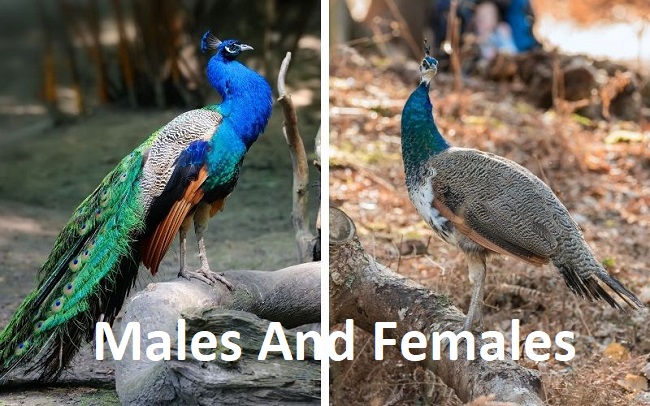Peacocks, also known as Peafowls, are renowned globally for their striking beauty and magnificent displays. While both sexes share commonalities, the differences between male and female Peacocks are quite striking.
This article, backed by veterinary knowledge, takes an in-depth look into the characteristics of male and female Peacocks, discussing their species, tails, and more.

Understanding Peafowls
Peafowls, belonging to the genus Pavo and Afropavo of the Phasianidae family, are native to Asia and Africa.
Read Also:
The term “Peacock” is commonly used to refer to these birds; however, it technically describes the male of the species. The females are “Peahens,” and the offspring are “Peachicks.” Collectively, they are known as “Peafowl.”
Notable Differences Between Male and Female Peacocks
Here are some of the difference between Male and Female Peacocks:
1. Size
On average, male Peacocks (Peacocks) are larger than their female counterparts (Peahens). Peacocks can reach lengths of 90-130 cm, excluding their lengthy train, while Peahens usually measure around 95 cm.
2. Plumage
The most noticeable difference lies in their plumage. Peacocks are famous for their bright, iridescent colors and extravagant tail feathers, known as a train, used for courtship displays.
Peahens, on the other hand, have a more subdued coloration, typically brown or grey, which aids in camouflage while nesting.
3. Tail Feathers
The train of a Peacock is a spectacular sight, spanning up to 5 feet and featuring eye-like markings known as ocelli. Peahens lack this train and have shorter, less decorative tail feathers.
Behavioral Differences
Males are known for their elaborate courtship rituals, which involve fanning out their beautiful tails and shaking them to attract a mate. Females, while less demonstrative, exercise choice in selecting their partners based on these displays.
Peacock Species
There are three species of Peafowls: the Indian Peafowl (Pavo cristatus), the Green Peafowl (Pavo muticus), and the Congo Peafowl (Afropavo congensis).
Indian Peafowl
The Indian Peafowl, the most recognizable species, is native to South Asia and known for the male’s blue and green-colored plumage and extensive tail train.
Green Peafowl
The Green Peafowl, originating from Southeast Asia, exhibits sexual dimorphism, but both sexes are more similarly colored than the Indian Peafowl. Males also have a striking train, albeit with different color patterns.
Congo Peafowl
The Congo Peafowl, native to Africa, is the least studied among the species. Both sexes have similar, less showy plumage compared to their Asian counterparts, with males lacking a long train.
The Life Cycle of Peacocks
After the courtship display, if the Peahen accepts the Peacock, the pair will mate. The Peahen then lays a clutch of eggs (typically 4-6) and incubates them for around 28 days. Unlike the males, female Peacocks play a significant role in rearing the young.
Understanding Peacock Sounds
Peafowls are known for their loud and unique calls. The males, or peacocks, use their calls for attracting females and warning off other males.
These calls, known as “hoot-dash” sequences, often accompany their visual displays. On the other hand, peahens make different noises like honking sounds, especially when they feel threatened.
Peacock’s Courtship Display: A Closer Look
One of the most stunning displays in the bird kingdom is the courtship ritual performed by male Peafowls. They raise and fan their long, ornate train into a semi-circular shape resembling a shimmering fan, shaking it in a specific pattern, producing a rustling sound.
This elaborate display, combined with a series of calls, aims to attract potential mates. Interestingly, recent studies suggest that peahens pay more attention to the lower eye-spots and the sound of the rustling feathers than the actual size of the fan.
Peafowls in Culture and Symbolism
Peafowls, especially Peacocks, hold significance in various cultures around the globe. In Hinduism, the Peacock is associated with the deity Lord Krishna, who is often depicted with Peacock feather in his headband. In Buddhism, the Peacock symbolizes wisdom and compassion.
In western culture, the Peacock is a symbol of beauty, royalty, immortality, and refinement. The phrase “proud as a Peacock” stems from the bird’s dignified and regal strut. The Peacock is also the national bird of India, representing the country’s vibrant and diverse beauty.
Conservation Status of Peafowls
While the Indian Peafowl is listed as “Least Concern” by the International Union for Conservation of Nature (IUCN), the Green and Congo Peafowls are at risk.
The Green Peafowl is categorized as “Endangered,” and the Congo Peafowl is “Vulnerable,” primarily due to habitat loss and hunting. Conservation efforts are ongoing to protect these magnificent species and their habitats.
Keeping Peafowls as Pets: Things to Consider
Peafowls can be kept as pets, but potential owners should remember they require plenty of space, preferably a large yard or farmland. They are best suited for rural or semi-rural settings due to their loud calls.
Their diet mainly consists of grains, insects, small mammals, and reptiles. Regular veterinary check-ups are vital to monitor their health and wellbeing.
Read Also:
Conclusion
The world of Peafowls is fascinating, filled with color, dance, and sound. Understanding the differences between male and female Peacocks—whether in terms of their physical attributes, behaviors, or roles in the life cycle—enriches our appreciation for these extraordinary creatures.
This knowledge is also vital for bird enthusiasts, helping them provide the best care possible for these stunning birds.
























